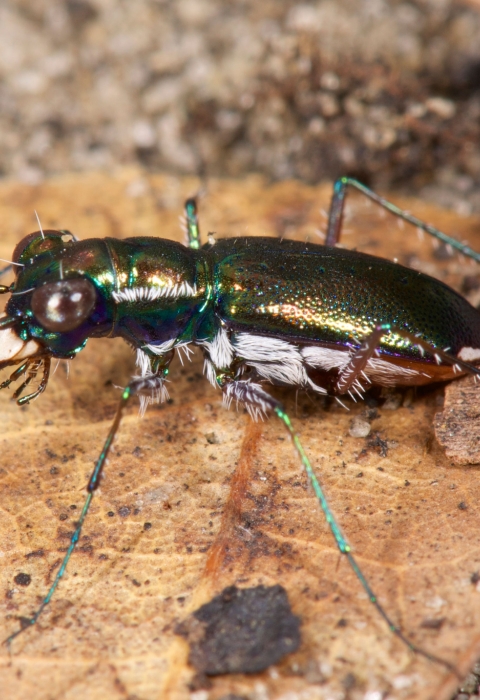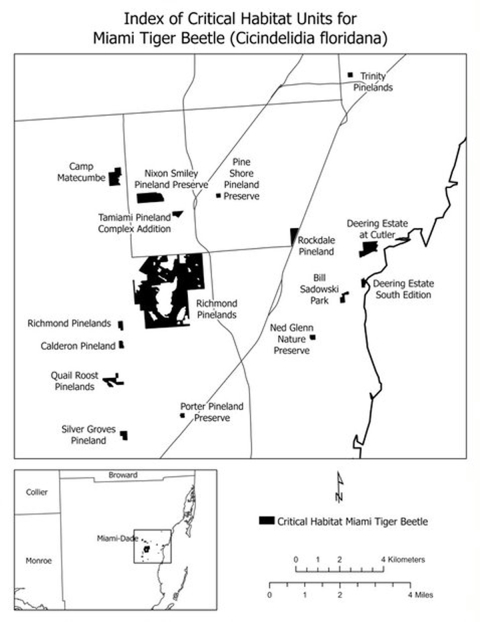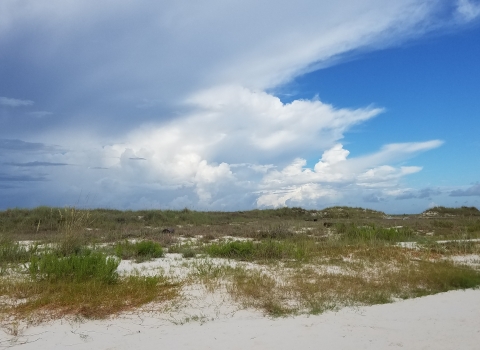What action is the U.S. Fish and Wildlife Service taking?
The U.S. Fish and Wildlife Service (Service) is extending the comment period on a proposal to designate critical habitat for the Miami tiger beetle by 45 days and scheduling a public hearing on the Sept. 7 proposed rule (86 FR 49945).
The proposed rule would designate approximately 1,977 acres as critical habitat for the species in Miami-Dade County, Florida. A draft economic analysis (DEA) is available for the proposed designation.
Why is the Service holding a public hearing and extending the comment period?
The Service is responding to a request received during the 60-day public comment period to hold a hearing to allow people additional opportunities to provide input on the proposed rule. Comments previously submitted need not be resubmitted and are fully considered in preparing the final rule.
How do I attend and participate in the hearing?
The virtual meeting is December 2, 2021, from 6-7:30 p.m. ET. Participants must register to receive the Zoom link and telephone number for the hearing. Registration information is available online at Virtual Public Hearing.
How do I submit comments on this proposal?
For directions on how to submit comments, visit the Federal eRulemaking Portal at (http://www.regulations.gov. In the Search box, enter FWS–R4–ES–2021–0053, which is the docket number for this rulemaking. Comments must be received before midnight Eastern Time December 23, 2021.
Are comments given at the public hearing afforded more weight than those submitted via the Federal eRulemaking portal?
All comments received are given equal consideration in reaching our final decision regardless of the submission method used.
What is the Miami tiger beetle and where does it occur?
The Miami tiger beetle is one of the smallest tiger beetles in the United States and was listed as endangered under the Endangered Species Act (ESA) in October 2016. It is shiny dark green on top with an orange abdomen and occurs in a unique, imperiled ecosystem known as pine rocklands. The Miami tiger beetle is only found in Miami-Dade County in south Florida.
What are the main threats to the Miami tiger beetle?
The major threats facing the Miami tiger beetle are habitat loss, degradation and fragmentation. An estimated 98 percent of historical pine rockland habitat suitable for this species within Miami-Dade County outside of Everglades National Park has been destroyed. This habitat loss is expected to continue because of inadequate habitat management, development, encroaching vegetation, and continued effects of climate change climate change
Climate change includes both global warming driven by human-induced emissions of greenhouse gases and the resulting large-scale shifts in weather patterns. Though there have been previous periods of climatic change, since the mid-20th century humans have had an unprecedented impact on Earth's climate system and caused change on a global scale.
Learn more about climate change . The small population size of this species and its restricted range adds to the severity of these threats.
How does the ESA define critical habitat?
The ESA defines critical habitat as the specific geographic areas that contain features essential to the conservation of an endangered or threatened species that may require special management and protection. Critical habitat may also include areas that are not currently occupied by the species but will be needed for its recovery.
How does the Service determine what areas to designate as critical habitat?
Within areas occupied by the species, biologists consider physical or biological features needed for life processes. These include:
Space for individual and population growth and for normal behavior;
Cover or shelter;
Food, water, air, light, minerals, or other nutritional or physiological requirements;
Sites for breeding and rearing offspring; and
Habitats that are protected from disturbances or are representative of the historical, geographical, and ecological distributions of a species.
After considering occupied areas, biologists consider unoccupied areas that may be essential for the conservation of the species.
What is the proposed critical habitat for the Miami tiger beetle?
In total, approximately 1,977 acres in Miami-Dade County, Florida, fall within the boundaries of the proposed critical habitat designation. The units being proposed for critical habitat include areas that were occupied by the Miami tiger beetle at the time of listing in 2016. Additionally, some units outside the current occupied areas are being proposed for designation. These currently unoccupied units are within the historical range of this species, contain suitable pine rockland habitat and essential physical and biological features, and have been determined to be essential for the conservation of this species.
The two units that were occupied at the time of listing in 2016 account for approximately 1,572 acres or 80 percent of the proposed critical habitat. The remaining 14 units total 405 acres or 20 percent of the total acreage being proposed. Of these 405 acres, only 16 acres are not currently designated as critical habitat for other federally listed species. Of the acres proposed for critical habitat designation, 25 percent are federally owned lands, 12 percent are state owned lands, 57 percent are county owned lands, and seven percent are private lands.
What is the draft economic analysis on this proposed action and why was it done? What did it find?
Draft economic analyses (DEA) are created to analyze the economic impacts of a proposed critical habitat designation. The DEA for the Miami tiger beetle found that the economic cost of implementing the rule will likely be limited to additional administrative effort in considering adverse modification of Miami tiger beetle habitat during Section 7 Section 7
Section 7 Consultation
The Endangered Species Act (ESA) directs all Federal agencies to work to conserve endangered and threatened species and to use their authorities to further the purposes of the Act. Section 7 of the Act, called "Interagency Cooperation," is the mechanism by which Federal agencies ensure the actions they take, including those they fund or authorize, do not jeopardize the existence of any listed species.
Learn more about Section 7 consultations. The proposed units are largely occupied by other federally listed species like Carter’s small-flowered flax, Florida brickell bush, Bartram’s scrub hairstreak butterfly and Florida leafwing butterfly. Conservation measures to avoid or minimize impacts to Miami tiger beetle habitat will likely overlap existing protections and efforts for already listed pine rockland species. As such, they are not expected to trigger additional requirements under state or local regulations.




